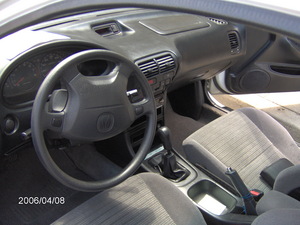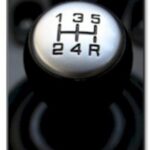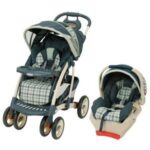Even the words “stick shift” are enough to inspire fear and hatred in the minds of some. Without a doubt, learning to drive a manual transmission vehicle can be a long and difficult road, although, with a good teacher and a little time, anyone can learn to become a talented shifter, and lose the fear that comes with the lack of a ‘D” by the shifter.
Perhaps the first necessary thing to do when trying to learn to drive stick is to simply sit in your car. Unlike an automatic transmission, driving stick requires that you have enough room by your feet to effectively operate the clutch, an adequate space in order to move the shifter, and enough room to feel comfortable while manipulating all of these variables. Try this; while just sitting your car, push the clutch in with your left foot and try shifting through the gears. If it feels comfortable, and it feels like something you can do on the road, than you’ve probably found your driving position. If it feels unnatural or uncomfortable, than try playing around with the seat some more until everything just feels “right”. You’ll know when you get it right.
Another important aspect of driving manual that most people tend to miss is that stick is a very hard skill to self teach. If possible, bring a friend or relative who knows what their doing along with you in your attempts to learn. This actually has a couple of advantages with it. Namely, you have someone sitting next to you who can give you advice and correct you on what you may be doing wrong. Also, if you happen to get in a spot you can’t get out of, or have a sudden emergency and have to head somewhere quickly; you have someone with you who can manage it.
Learn to use the parking brake! Many new stick drivers have fallen prey to forgetting that they need to put the parking (emergency) brake on when they wish to park their car. Unlike an automatic, a manual transmission car does not have a separate set of parking brakes, and if one is leave the car in neutral and turn it off without the brake, the car can actually roll away. In order to stop this, leave your vehicle in either first or reverse, and apply the parking brake before getting out of the car. At the same time, when getting in your car for the first time, make sure that the parking brake is fully down before attempting to drive. The emergency brake has a few other important uses as well. For new drivers, starting the car on a hill can be tricky. In order to make this just a tad bit easier, apply the parking brake before attempting to start. Then, when you feel the clutch start to catch, simply disengage the brake, this will prevent your car from rolling backwards when trying to go uphill.
Going downhill: For anyone who has serious trouble starting out in first gear, try bringing the car to a place with a slight downhill incline, this will allow the car to roll forward slightly while you attempt to work the clutch, with the car already moving slightly, it should be a much more natural transition into normal driving. Also, if one cannot seem to get started in first gear, try this little experiment: Start the car with the shifter in neutral, then, without touching the gas, move the shifter to first gear and slowly let of the clutch, without touching the gas. When you feel the car start to stall, then you also know approximately at what point you should release the clutch when giving it gas, it just simplifies the concept a little bit.
Remember to use the right gear! Perhaps one of the hardest things to get used to when driving a manual car is the idea that the car no longer thinks for the driver. Those new to stick may forget that just getting to fourth or fifth gear is not enough, a driver has to be active in driving the car. When going up a hill, if you feel your car start lagging or see the speedometer falling, it would be a good time to downshift (select a lower gear), this will give you the additional power and torque that is needed to make it up a steeper hill. To downshift effectively, it must be done quickly. Without hesitation, push the clutch in, move the shifter, and give the car a slight bit of gas before letting the clutch out, if done properly, you should feel the difference in your car, and also be able to make some progress up that hill.
Don’t over/under rev! Another common mistake when learning to drive stick is the tendency to shift either too soon or two late. Shifting too soon, before the engine is running quickly enough, will rob your vehicle of power and the engine will start to choke and lag. However, shifting too late will be difficult to new drivers and will put undo stress on both your engine and your transmission. Although all cars tend to vary a slight bit, a general rule of thumb is to shift to the next gear around 3,000 rpm, this will be a nice transition point from gear to gear, and will not stress nor choke your engine. If you find the 3,000 rule ineffective in your own vehicle, just play around a little bit to determine when the best shift point is in every gear.
The value of parking lots! New clutch drivers may find themselves very stressed by the challenges of the road and other traffic. In order to solve this problem, locate a large and preferably empty parking lot. Simply practice starting and stopping the car there until you feel comfortable enough to drive on the road. If the parking lot is large enough, try going from first to second gear, simply to get a feel of what real driving will be like.
Don’t stress! It’s really not that simple of a process to learn to effectively drive stick, but staying calm and focused can really make all the difference. If a drive is starting to worry or stress about their driving, they will not perform nearly as well as they would in a relaxed or happy state. Remember never to get frustrated while trying to drive stick (or any car) it’s important to keep anger off of the road and not take your problems out on your car. Just remember to stay calm at all times and learning to drive will be that much easier.
Learning to drive a manual transmission can really be a lot of fun, but it’s not for everyone, and learning whether or not it’s really something you want to do can be invaluable. However, if you really want to drive stick, than you simply need to practice, it’s a long road, but it will lead to success in the end.




